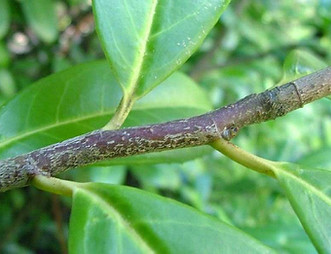

Ireland: Kerry - Dublin - Cork - Waterford - Roscommon - Galway - Belfast
UK: London - Manchester - Newcastle - Cardiff - Liverpool
Cherry Laurel
Invasive Species Information


What Is Cherry Laurel - (Prunus laurocerasus)?
Habitat: Terrestrial
Distribution in Ireland: Widespread
Status: Established
Family name: Rosaceae
Common name/s: Cherry laurel, common laurel, English laurel
The flower buds appear in early spring and open in early summer in erect 7–15 cm racemes of 30–40 flowers, each flower 1 cm across, with five creamy-white petals and numerous yellowish stamens with a sweet smell.

Cherry Laurel fruit

Cherry laurel is an evergreen shrub or small to medium-sized tree, growing to 5 to 15 metres tall, rarely to 18 metres, with a trunk up to 60 cm broad.
The leaves are dark green, leathery, shiny, 5–30) cm long and 4–10 cm broad, with a finely serrated margin.
Leaves can have the scent of almonds when crushed.
Cherry Laurel Branch
The fruit is a small cherry 1–2 cm broad, turning black when ripe in early autumn can have the scent of almonds when crushed.
Leaves, fruit and seed may cause severe discomfort to humans if ingested.
The seeds contained within the cherries are poisonous like the rest of the plant, containing cyanogenic glycosides and amygdalin.
This chemical composition is what gives the smell of almonds when the leaves are crushed. Laurel water, a distillation made from the plant, contains prussic acid and other compounds and is toxic.
How To Identify Cherry Laurel?

Cherry Laurel - Elodea canadensis leaves
Leaf: dark green, leathery, shiny, 5–30) cm long and 4–10 cm broad
Flower: 1 cm across, with five creamy-white petals and numerous yellowish stamens with a sweet smell.
Fruit: small cherry 1–2 cm broad, turning black when ripe containing single seeds.

Cherry Laurel fruit & seed

Cherry Laurel flowers
Why Is Cherry Laurel A Problem?
Cherry Laurel is an alien (non-native) invasive plant, meaning it out-competes crowds-out and displaces beneficial native plants that have been naturally growing in Ireland for centuries.
Its rapid growth, coupled with its evergreen habit and its tolerance of drought and shade, often allow it to out-compete and kill off native plant species. It is spread by birds, through the seeds in their droppings..
European Communities (Birds and Natural Habitats) Regulations 2011 non-native invasive plant species A-Z (Updated 2017)
There are currently 35 invasive plant species listed in the European Communities (Birds and Natural Habitats) Regulations (annex 2, Part 1)...
Click on a species from the following list to find out more regarding non-native species subject to restrictions under Regulations 49 and 50.
-
American Skunk-Cabbage - Lysichiton americanus
-
Brazilian Giant-Rhubarb - Gunnera manicata
-
Broad-Leaved Rush - Juncus planifolius
-
Cape Pondweed - Aponogeton distachyos
-
Cord-Grasses - Spartina (all species and hybrids)
-
Curly Waterweed - Lagarosiphon major
-
Dwarf Eel-Grass - Zostera japonica
-
Fanwort - Cabomba caroliniana
-
Floating Pennywort - Hydrocotyle ranunculoides
-
Fringed Water-Lily - Nymphoides peltata
-
Giant Hogweed - Heracleum mantegazzianum
-
Giant Knotweed - Fallopia sachalinensis
-
Giant-Rhubarb - Gunnera tinctoria
-
Giant Salvinia - Salvinia molesta
-
Himalayan Balsam - Impatiens glandulifera
-
Himalayan Knotweed - Persicaria wallichii
-
Hottentot-Fig - Carpobrotus edulis
-
Japanese Knotweed - Fallopia japonica
-
Large-Flowered Waterweed - Egeria densa
-
Mile-a-Minute Weed - Persicaria perfoliata
-
New Zealand Pigmyweed - Crassula helmsii
-
Parrots Feather - Myriophyllum aquaticum
-
Red Alga - Grateloupia doryphora
-
Rhododendron - Rhododendron ponticum
-
Salmonberry - Rubus spectabilis
-
Sea-Buckthorn - Hippophae rhamnoides
-
Spanish Bluebell - Hyacinthoides hispanica
-
Three-Cornered Leek - Allium triquetrum
-
Wakame - Undaria pinnatifida
-
Water Chestnut - Trapa natans
-
Water Fern - Azolla filiculoides
-
Water Lettuce - Pistia stratiotes
-
Water-Primrose - Ludwigia (all species)
-
Waterweeds - Elodea (all species)
-
Wireweed - Sargassum muticum
Non-Native Plant Species identified as High Risk on Ireland's Biodiversity List...
Common name
Cherry Laurel
Chilean Rhubarb
Species name
Environment
Terrestrial
Freshwater
Terrestrial
Terrestrial
Marine
Freshwater
Freshwater
Freshwater
Terrestrial
Terrestrial
Terrestrial
Terrestrial
Marine
Terrestrial
Freshwater
Freshwater
Freshwater
Terrestrial
Freshwater
Marine
Risk score
20
19
18
19
18
19
21
20
19
18
18
19
19
20
20
19
20
20
20
18

